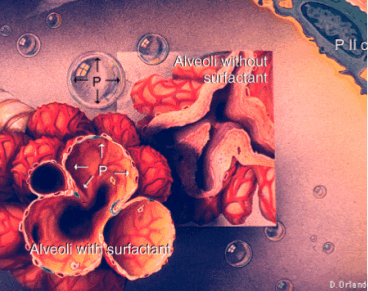PT 861 - The High Risk Infant
Physiological status of the pre-term infant: Part I - Respiration
Indicate if each of the following statements about pre-term birth is true or false?
Clinically, pre-term birth is subdivided into two categories: moderate pre-term and very pre-term. Very pre-term is used to identify infants born at less than 36 weeks of gestation.
True False
The role of pulmonary surfactant is to reduce the surface tension of the alveoli?
True False
- Infants born prematurely tend to experience varying degrees of difficulty in meeting the physiological demands of early post-natal life. As a general rule, the earlier the infant is born, the higher the degree of difficulty in maintaining physiological homeostasis during the transition from pre- to post-natal life. Respiration and brain perfusion are two functions that are highly sensitive to the degree of prematurity.
- The physiological readiness of the lungs to support adequate post-natal ventilation is one of the determinant factors of a neonate's survival and long-term outcome. This physiological readiness is related to the presence of sufficient concentrations of surfactant to provide mechanical stability to the alveoli (and smallest bronchioles) and to the capacity of alveolar epithelial Type II alveolar cells to produce, remove and recycle surfactant.
-
Surfactant reduces surface tension throughout the lung, thereby contributing to its general compliance, as well as stabilizing the mechanical response of alveoli to repeated cycles of inflation / deflation.
-
From fluid mechanics, we know that the pressure within a spherical structure with surface tension, such as the alveolus, is inversely proportional to the radius of the sphere. Therefore, at a constant surface tension, we would expect the internal pressure in a small alveoli to be much greater than that of surrounding larger alveoli. This differential pressure of alveoli is one of the causes of atelectasis: the collapse of smaller alveoli when the inspiratory pressure is no longer sufficient to expand them.
- Collapse of the smaller alveoli, however, does not generally occur because surfactant differentially reduces the surface tension of alveoli based on their size.
- This means that smaller alveoli will have more surfactant and will be inflated at the same partial pressure as larger alveoli. In this way, surfactant ensures alveolar stability throughout the lung and improves overall ventilation capacity.

- Pulmonary surfactant is formed relatively late in fetal life; sufficient quantities to maintain the mechanical stability of the lung are not present until 32 weeks of gestation. Premature infants born without adequate amounts of pulmonary surfactant will experience respiratory distress, and may die.
- The signs and symptoms of respiratory distress include: grunting respiration, use of accessory muscles and nasal flaring appearing soon after birth.
RESPIRATORY DISTRESS IN PREMATURE NEONATE
- It is not only the absolute amounts of surfactant that are an issue in prematurity, but as well the physiological capacity of the type II alveolar cells to synthesize, absorb and recycle surfactant. It is therefore not uncommon for a premature infant of 28 to 32 weeks gestation to breath normally early in the post-natal period but to soon develop breathing problems.
- The use of corticosteroids prior to birth will increase the maturity of the type II alveolar cells and increase the overall rate of production of pulmonary surfactant. Every extra day improves the survival chances and health outcomes of the very pre-term fetus and hence the importance of education programs around the prevention and recognition of pre-term labour.